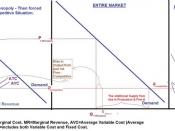1. Introduction
This report begins with a short background description of where the idea of industrial clustering came from and a summary of industry cluster characteristics. Next it outlines the potential advantages and disadvantages clusters provide regional economies. In conclusion, I will summarise by advising whether or not Development Agency should concentrate its resources on development of clusters.
2. Background
More than hundred years ago Alfred Marshall came up with the idea that a success of national economy does depend on the development of localised concentrations of industrial specialisation. He stated that during 19th century, Britain's economic growth was a cause for the development of several examples of localised industries. Recently, Michael Porter updated Marshall's concept of industrial localisation, "...in particular his identification of contemporary local agglomerations, based on a large-scale empirical analysis of the internationally competitive industries for several countries, has been especially influential."
3. Industry cluster characteristics
"Professor Michael Porter summarised the concept of clusters as follows:
A cluster is a critical mass of companies in a particular field in a particular location, whether it is a country, a state or region, or even a city.
Clusters take varying forms depending on their depth and sophistication, but most include a group of companies, suppliers of specialised inputs, components, machinery, and services, and firms in related industries. Clusters also often include firms in downstream industries, producers of complementary products, specialised infrastructure providers and other institutions that provide specialised training, education, information, research, and technical support, such as universities, and standard-setting agencies. Government agencies that significantly influence a cluster can also be considered a part of it."
Each cluster is unique as a result of differences in industry sectors, number and sizes of firms, purchase-sale linkages, and extent of firm's internal cooperation and interaction.
According to Markusen (1994) four general...


